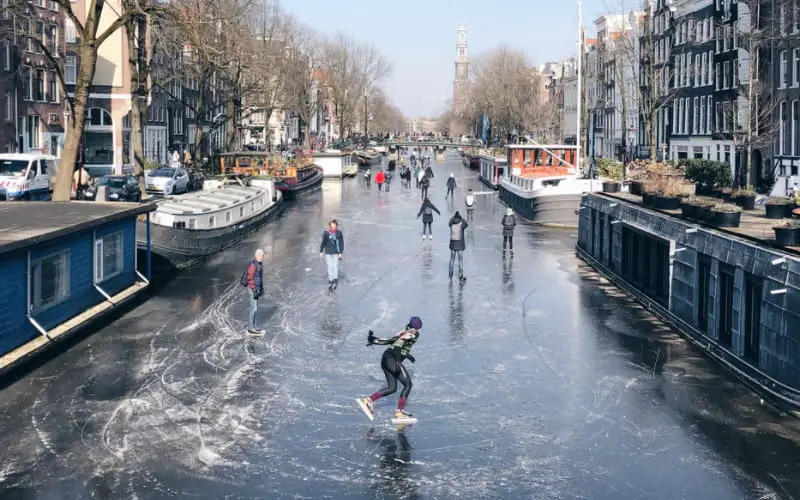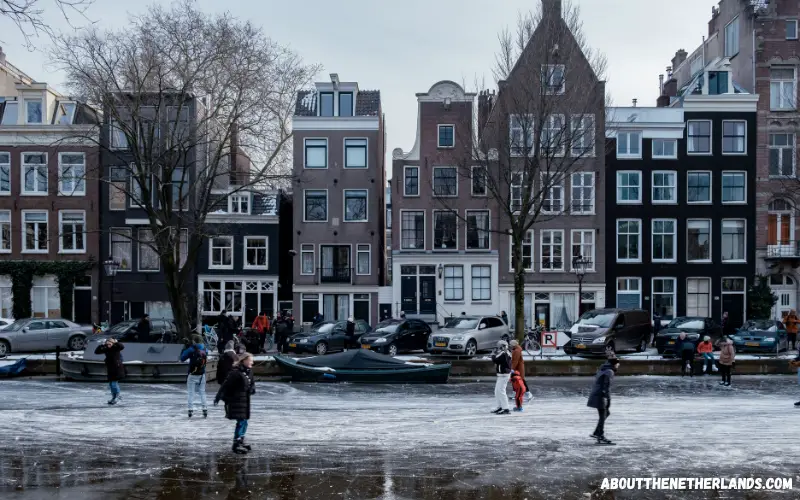

The picturesque canals of Amsterdam are a sight to behold, especially when they freeze over, creating a winter wonderland and providing an opportunity for locals and visitors to engage in ice skating. In recent years, it has become less common for the canals to freeze, as global warming impacts the climate.
Amsterdam last witnessed its canals freezing over in February 2021 and March 2018, which sparked excitement in the city. This extraordinary event was a rare delight, as the previous occurrence of frozen canals dates back to 2012, demonstrating the scarcity of such instances in modern times.
This rare phenomenon is visually stunning and offers a unique recreational opportunity to ice skate on the canals, an activity the Dutch are eager to enjoy when the icy conditions allow it.
Amsterdam's canals have a storied past, starting over 400 years ago. They were crucial to the economic and cultural boom during the 17th century, often referred to as the city's Golden Age.

The three main and probably most famous canals that make up the canal belt are the Herengracht, Prinsengracht, and the Keizersgracht. During this period, the city expanded, and the intricate system of navigable waterways was developed, giving Amsterdam its unique layout and charm.
Until the mid-1980s, it was relatively common for Amsterdam's canals to freeze almost every year. However, as global temperatures have risen, freezing events have decreased. These events have become rarer in recent decades, occurring about once every five years.
The last time skaters could safely glide along the surface of the canals was in 2018, when a sustained cold spell allowed for a thick layer of ice to form. On these rare occasions, the city works to protect the canals by closing off certain sections, preventing boat traffic, and allowing the water to freeze undisturbed.

In February 2021, the canals could also be skated for a few days in some places. However, the ice then was of very poor quality, and only a few daredevils took to the ice.
Climate change is one of the main factors influencing the frequency of canal freezes in Amsterdam. Like many other countries, the Netherlands has experienced an increase in average temperatures over the years, leading to reduced instances of canals freezing over.
In the past, the canals used to freeze almost every year until the mid-1980s, but the last time the canals were skated was in 2021, 2018, and 2012.
Winters have become milder, leading to snow arriving later in the year, such as in mid-January instead of December. This shift in weather patterns has contributed to the reduction in the frequency of canal freezes and skatable conditions for residents and tourists alike.
Another factor influencing the freezing of Amsterdam's canals is the management and control strategies employed by the city.
In order to preserve the canals and facilitate ice formation during possible freezing periods, the city closes certain sections of the 17th-century canals, preventing boats from entering and causing a current. This strategy allows the water to freeze over.
When periods of freezing cold are expected, these control measures are put into place, and some canals may freeze over. However, caution is required as not every canal that appears to be frozen has a thick enough ice layer for safe ice skating.
In any case, management and control strategies play a role in determining whether or not the canals will freeze and be suitable for ice skating.

The last time Amsterdam's canals froze solid was in 2021; this rare event had several economic impacts on the city. Ice-skating and winter activities on the frozen canals attracted tourists, benefiting local businesses such as restaurants, cafes, and hotels in the area.
Additionally, the increased interest in ice skating led to a boost in sales for winter sports equipment retailers.
During the freezing of canals, water-based transportation like canal cruises and water taxis came to a temporary halt. This situation forced tourists to find alternative means of transportation, such as biking, walking, or using public transport.
The frozen canals created unique recreational opportunities for both locals and visitors. For the first time in years, people had a chance to enjoy ice skating on Amsterdam's famed waterways (The Guardian).
This rare event brought communities together, fostering a festive atmosphere across the city. Impromptu skating parties, games, and other forms of social interaction took place on the ice, strengthening the bond among residents and creating lasting memories.
As climate change continues to affect weather patterns, the future prospects of Amsterdam's canals freezing over become uncertain.
In this section, I will discuss the preventative measures being considered and how the city is adapting to changing conditions.
Various preventative measures are being explored in response to the threats that climate change poses to the likelihood of Amsterdam's canals freezing.
One such initiative involves investing in sustainable technologies that can help reduce the city's carbon footprint and mitigate the effects of global warming on local weather conditions.
Through these efforts, the hope is to preserve the possibility of the canals continuing to freeze over in the future.
Amsterdam is continually adapting to the changing conditions that come with shifting weather patterns. For example, the city has implemented infrastructure improvements and maintenance plans to ensure that the canals remain accessible and safe for recreational activities, regardless of whether they freeze over or not.
Additionally, the city promotes alternative outdoor winter activities to keep residents and visitors engaged should the canals not freeze consistently.
Overall, Amsterdam is working proactively to address the future prospects of its iconic canals freezing over. By implementing preventative measures and adapting to changing conditions, the city aims to preserve this cherished tradition for future generations.
In recent history, the last time Amsterdam's canals froze was in 2021, 2018, and 2012, providing locals and tourists with a rare opportunity to ice skate on the frozen waterways. This exceptional event attracted people from all over to enjoy the unique experience.
While it was more common in the past for canals to freeze almost every year, climate changes and overall warmer temperatures have made this occurrence increasingly infrequent. Prior planning and the city's efforts to close off certain sections of the canals can help facilitate freezing when conditions allow for it.
Whether the canals will continue to freeze over in the future remains uncertain as climate change continues to affect weather patterns.
The rarity of these occasions only serves to heighten the excitement and sense of community when the residents of Amsterdam have the opportunity to skate on their beloved canals.